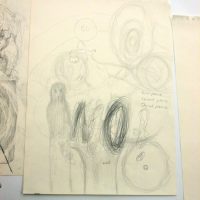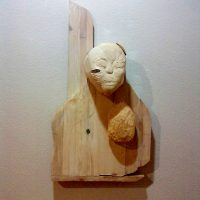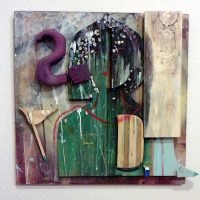Roza El-Hassan’s characteristic social role and political sensitivity have defined and continue to define her career, the fact that she is among the most well-known Hungarian artists in the international scene. This exhibition is centred around her works that present the artist’s personal freedom: her wooden sculptures and free association drawings. Perhaps the meaning of this choice is that the international events (for example, the Syrian events that affect Roza El-Hassan through her family) have a significance beyond the individual’s responsibility, cognizance, and what is rationally comprehensible and understandable.
The artist was interviewed for the exhibition.
Roza El-Hassan: The sculptures and the drawings aren’t connected to the daily political events, but they began with an earlier political work: R. is thinking/dreaming about overpopulation (2000), that was inspired by an exchange of e-mails (Milica Tomic–Branimir Stoyanovic–Roza El-Hassan).
Brigitta Muladi: Your piece about the crouched female figure covered by a black sheet has become emblematic, the Vienna EVN collection purchased it, and as far as I know, you were asked to re-create it again.
R. E-H.: That was the first figure I made, this sitting sculpture covered by a sheet was made of wood, and then indeed, they ordered another one of it, but I cannot repeat myself, I can’t make a copy of a piece for two exhibitions, so I didn’t cover it with textile, instead I left the wooden structure bare, and this is how I accidentally came up with the series of figurative sculptures. For me, the non-figurative is apolitical, not for everyone else though, but for me the figure is always connected to human rights — ever since I became interested in political issues, I’ve been working with figures. Of course, in the beginning the abstract had socio-political content, and it was about the autonomy of art, but in my experience, it became merely gratuitous decoration in many cases, although its concept of freedom would still be relevant.
For me, sculptures are three-dimensional drawings, I realized that I can sketch with wood in space just like with a pencil on paper. I hatch it roughly or elaborate a fine detail, or incise it with a chisel, and it re-creates the freedom of drawing in space. I can work with it as freely as with a drawing, practically it makes it possible to present the freedom of drawing in space.
B. M.: Among your exhibited works in the Inda Gallery, there are two central reliefs, that you said are each other’s opposites. What did you mean by that?
R. E-H.: For me, these two sculptures represent the light and the darkness, chaos, violent emotions. The crude wooden piece is titled Enigma, it’s a “light” sculpture, while the other one is painted in dark colours, and similarly to my drawings, I painted several layers onto each other, and I scattered pebbles on its surface.
B. M.: The patterns, dots, circles, nets, tendrils, heart-shaped motifs and colours on your sculptures are similar to your drawings. Do they mean anything, or are they symbolic?
R. E-H.: No, I didn’t intend a meaning. They are playful, connected to the visual, not the oral — forces, people, emotions. The circle is always positive, or it can be a dimension-jump, a tunnel. This language isn’t connected to speech. When I create the reliefs, I paint several layers, but I can feel the right rhythm, whether to stop or leave it out or re-paint it.
B. M.: Is it accidental or intentional that the “light” piece has masculine features and the “dark” one feminine? Rationality and logical thinking are masculine features in esoterism and Eastern philosophies, while intuition and emotions are feminine features, and at the same time, the physical creation is also connected to women. Albeit somewhat archaic, according to the Freudian-Jungian system we all possess the features of animus and anima. You didn’t use them on purpose, yet you subconsciously created a kind of unity.
R. E-H.: An artist doesn’t have to answer to that, but why not. I don’t usually plan these things, I only create. The personal space and a way to manage our violent energies are in the piece. Obviously the crude sculpture resembles a male figure with a chopping tool placed near the heart, and the other one, the coloured one is clearly a female figure, we connect the red mouth to women, it’s a female symbol, but both can be found in both figures, and I made several figures in the same sculpture, or next to each other.
There’s a lot of passion in them. These sculptures, just like most of my drawings are intuitive, they stem from my subconscious, or rather, the unfathomable, I cannot predict what form they will take. I switch off consciousness, and the emphasis is placed on the process itself. On the other hand, I plan and precisely execute my projects, performances and actions, and I can talk about them at length.
These are forces, motifs of emotions, you can see the red lips, the passion, the chaos, the opposite forms, entropic, dark colours, maybe aggression as well, but when I created it, it wasn’t conscious.
The piece with the chopping tool is light and positive, but the chopping tool also represents violence, the life of the prehistoric man was narrowed down, his existence was full of suffering. We can see this limited, narrow life on the cave paintings: the desire to break free, as our ancestor scratches the stone almost barehanded.
B. M.: As for the archaism, one of your earlier works is here, built into one of the sculptures. It’s the chopping tool. What does it mean and why did you apply it on this piece?
R. E-H.: The chopping tool gave it the intellectual start. There was a big conference about archaic art for the birthday of Gottfried Böhm, and Horst Bredekamp was there, and they had a theoretical argument about the origins of visual arts.iii They said that the picture existed before the language. It was proven that the homo sapiens scratched patterns into the chopping tool a 100,000 years before the Neanderthal, it was the first tool, and they thought it wasn’t conscious. But according to Bredekamp, if there was a fossil in the chopping tool, the prehistoric man was aware of it, didn’t damage it, and made it symmetrical. He simply dated our evolution back 250,000 years before homo sapiens. The flint was shaped for the palm, slightly asymmetrical, so as to be held in a hand. This was the first aesthetic object of humankind. I made the chopping tool of wood, and for a long time, I didn’t know how to exhibit it. In museums, it was fixed on two small metal poles, earlier I put it in bowl, which was a feminist, matriarchal cliché, I also drew a picture of it. Then I started working on the sculpture, and I realized that if I place it on the figure, the method of installation is solved. Basically this sculpture is also a supporter.
B. M.: In conclusion, I think these graphic and three-dimensional pieces were created in a continuous arch, out of permanent, often re-appearing elements, as opposed to the projects, that are changing reactions to the actual socio-political environment, but these two topics are always in an interrelationship.
R. E-H.: The sculptures, reliefs and drawings that create a unity here, and the “free art”, are all part of my work, when we don’t necessarily have to take responsibility for others or for our own words like I do as an organizer or in political statements. They are connected to my private, mental sphere, they express an experience that is not directly political, and they are made without trying to explain what is going on in the world. There is no clear social role in them, they are connected to the private sphere, but the human experience is also there, and we always take responsibility, but in this case I handle these concepts more freely, than in a statement regarding human rights or an experiment in political mediation that I consider a failure.
Brigitta Muladi



